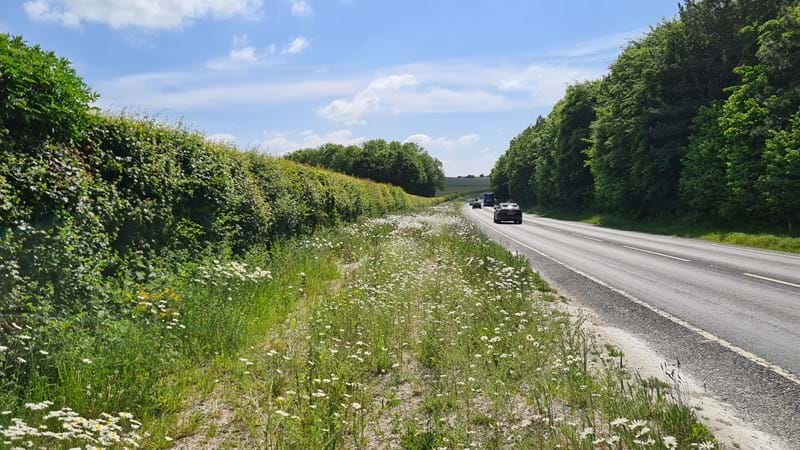We're improving biodiversity and reducing costs

Share this article
Two drainage schemes on the A35 have given us the opportunity to help boost biodiversity while saving money.
Instead of importing topsoil and seeding with grass, we funded the introduction of native wildflowers on the roadsides. This will support populations of pollinators such as bees and butterflies, as well as other insects - as well as being visually appealing.
The work took place last autumn and involved seeding and restoring:
- 2,000 square metres of verge around the Monkey’s Jump roundabout
- 3,000 square metres around the Max Gate junction
- a further 1,000 square metres of land around the Max Gate pond area
Species we seeded include Horseshoe and Kidney Vetch, Bee Orchids, Cowslip and Oxeye Daisy. Our contractors, Knighton Countryside also created winter havens for other species, such as toads, hedgehogs and snakes.
Using chalk waste and rough soils from the drainage schemes reduces the need to import materials. This helps the environment and saves money. As we move into summer and flowers bloom, we're starting to see the benefits of this approach.
The bordering Duchy of Cornwall estate advised us how best to landscape the locations. We financed the work through our Designated Fund for the environment and wellbeing.
National Highways’ Environmental Advisor Ben Hewlett said:
“We now have a policy to introduce low nutrient soils and wildflower verges as part of our major projects programme and working with groups such as Natural England and Butterfly Conservation, it’s good to see this spreading into our regional maintenance and improvement work.
“The increase in wildflowers will not only have wider biodiversity benefits and provide some impressive visual displays, but it will also help to connect people with nature and improve the wellbeing of millions of people using our roads every day.”
Clare Warburton, Natural England's Green Infrastructure Principal Advisor, said:
“We welcome this step change in the way road verges are designed and managed, and this could make a significant contribution to recovering nature on our verges.
“Low nutrient verges can help to reduce the likelihood of invasive species like creeping thistle, and increase native species we love to see, like oxeye daisy and bird’s-foot trefoil and even rarer flowers, such as orchids, as well as being great for bees and pollinators.”
Mark Schofield, Plantlife’s National Road Verges Advisor, added:
“This new way of working is part of the systemic change our green infrastructure management needs if we are to reverse nature’s decline, and this exciting move to reduce verge fertility is an effective way to reduce cost to the public purse and to reduce the carbon footprint of construction and maintenance, while improving road user safety due to reduced vegetation growth.
“The creation of more natural and less fertile soils in this way supports a greater diversity of native plants and the rest of biodiversity that depend upon them.”
Designated funding for environment and wellbeing
Through our Designated Funds, we're also delivering biodiversity enhancements on M4 verges in Wiltshire and the A46 near Bath. We've also assisted the Westcountry Rivers Trust to install fish passes on the River Lemon beneath near Newton Abbot and at Ashburn Check Weir, Buckfastleigh.
We're also supporting Cornwall Wildlife Trust's enhancements to land bordering the A30. Our funding will help to restore and recreate 16.8 hectares of woodland, orchard, grassland and heathland north of Truro.
Find out more about nature and our road network.
